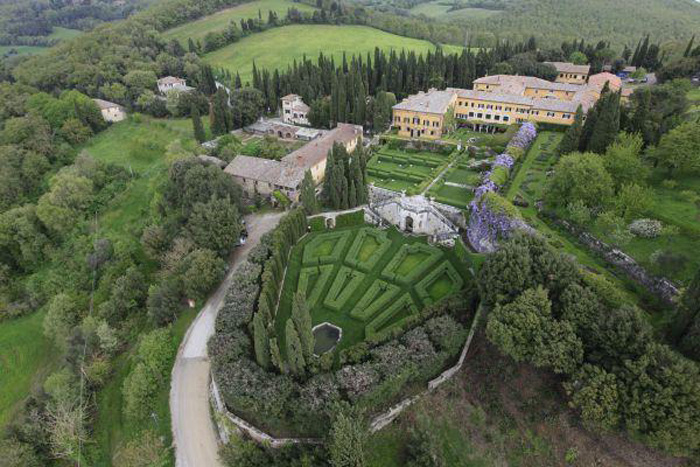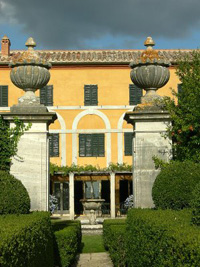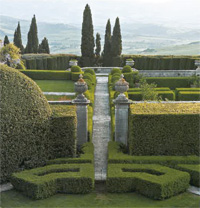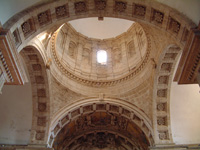|
| |
Villa La Foce |
La Foce is a re-created renaissance style garden designed by Cecil Pinsent between 1927 and 1939 for Iris Origo, a writer and horticulturalist. After moving to the area in 1924, the Origos dedicated their lives to the development and progress of the Val d'Orcia and its people. The gardens and estate of La Foce constitute one of the most important and best kept early twentieth-century gardens in Italy. |
'Tuscany, in most people’s mind, evokes appealing images of a centuries-old civilization, a place where |
|
|
The Pergola |
||
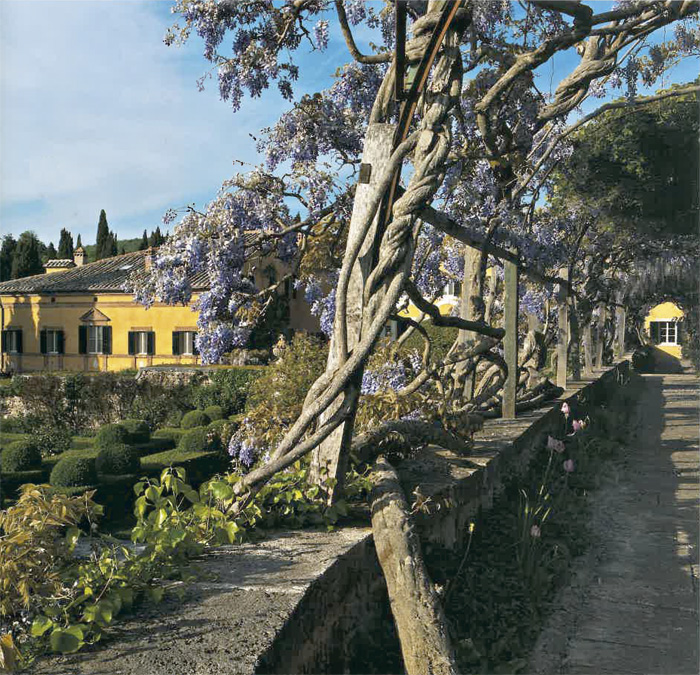 |
||
A wooden pergola supports a purple flowering wisteria over a stone path |
||
The famous winding road with cypresses |
||
The famous cypress road that winds up a hill, one of the most photographed views of Tuscany. But they also have a story, for they were planted by Marchese and Marchesa Origo (the writer Iris Origo) as part of a scheme to improve the landscape of what was then among Italy's most desolate regions. They also, no doubt, softened the view from the masterpiece the idealistic young couple created nearby, at what had been until their arrival a wayside inn: one of the most dramatic twentieth-century gardens. |
||
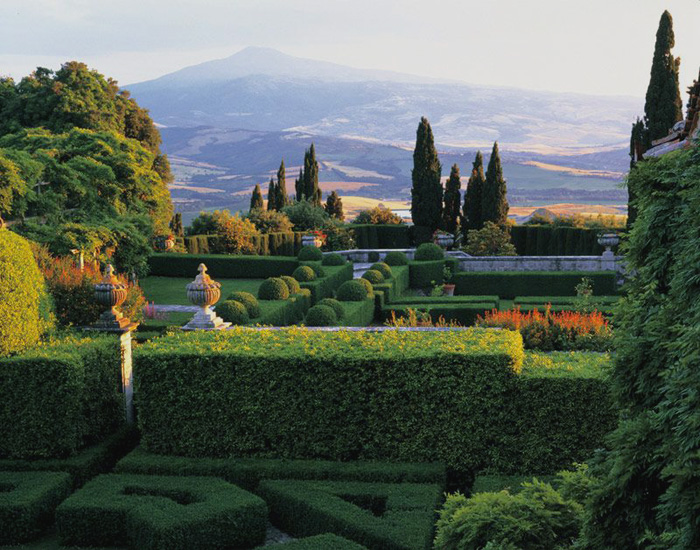 |
||
A view across the garden towards a horizon dominated by the volcanic peak of Monte Amiata. View of the formal landscaping below the belvedere in the garden at La Foce in Tuscany. The harmony between this garden and the surrounding nature makes la Foce an ideal example of Tuscany’s architectural and cultural evolution in the 20th century. |
||
| La Foce has also become a centre for cultural and artistic activities. Castelluccio (literally little castle), a mediaeval castle on the property, is the home of an international music festival, Incontri in Terra di Siena. It also hosts art exhibitions, as well as courses on garden history and landscaping. Each summer, the cultural association La Tartaruga organizes art shows at the medieval castle Castelluccio. The curator, Plinio de Martiis (known for his important gallery in Rome) has in recent years brought the work of renowned artists such as Kounellis and Manzoni to Castelluccio, as well as promoting young, less famous artists. Incontri in Terra di Siena is a not-for-profit cultural association, in memory of Antonio Origo and his wife Iris, the well-known Anglo-American writer. Based at Villa La Foce and the nearby medieval castle, Castelluccio, Incontri's aim is to spread the appreciation of music and art through concerts, meetings, and artistic events held in the many beautiful neighbouring towns that include Pienza, Radicofani, Cetona, Città della Pieve and San Quirico d'Orcia. The Incontri in Terra di Siena chamber music festival has branched out, gathering regional and international support. It is a key part of a wider initiative to sustain the area, the passion that originally drove the Origos. Incontri in Terra di Siena | www.itslafoce.org |
 Castelluccio |
|
Map |
||
|
Villa La Foce enlarge map |
||||
|
||||
Tuscany is one of the most popular tourist destinations in the world. Known for its enchanting landscapes, its fantastic and genuine food and beautiful towns as Florence, Pisa, Lucca and Siena. Podere Santa Pia is an elegant and luminous house and attached apartment in the characteristic Maremma region, just a few steps from Montalcino, Pienza, Montepulciano, Abbadia di Sant' Antimo and San Quirico d'Orcia, famous for their artistic heritage, wine, olive oil production and gastronomic traditions. The strategical geographical position in southern Tuscany will give you the opportunity of arriving in Siena and other important cities of art in Tuscany, such as San Gimignano, Volterra and Massa Marittima. Podere Santa Pia , with its wide panoramic terrace overlooking the Maremma, is the ideal place to enjoy the beauty of Tuscany and to pass a very relaxing holiday in contemplation of nature, with the advantage of tasting the most typical dishes of Tuscan cuisine and its best wines. The extreme simplicity of Tuscan cuisine is its strongest strength, as the flavours that emerge during the cooking process are vibrant and pure. A little known fact about Tuscan cuisine is that the French learned how to cook from their Tuscan counterparts when it was imported by Catherine de' Medici into the court of Henry II. The Tuscan style of cooking is richly flavoured and wholesome. With its original kitchen and the wood burning pizza oven, Casa Santa Pia offers an upbeat atmosphere. Tuscan Holiday houses | Podere Santa Pia |
||||
 |
||||
Podere Santa Pia |
Podere Santa Pia, garden |
Castel Porrona, a charming medieval village dating back to the 11th century, between Cinigiano and Castiglioncello Bandini and Podere Santa Pia | ||
| Tuscany, in most people’s mind, evokes appealing images of a centuries-old civilization, a place where nature itself appears tamed and enhanced by the presence of man. in contrast, the val d’orcia comes as a shock to the stranger driving south from chianciano toward the via cassia. The traveller suddenly reaches the top of a pass overlooking a wide valley below: this is la Foce. everything that can be seen from here appears conceived on a larger scale, very different from any other place in Tuscany. The property of La Foce lies on the hills overlooking the Val d'Orcia, a beautiful and miraculously intact valley in Southern Tuscany. The area of Val d'Orcia is a part of the agricultural landscape of Siena, which was developed and redrawn when it was made a part of the city-state in the 14th and 15th centuries. Val d'Orcia's landscape, with its fortified villages and small towns, is typical of the area and had inspired several artists. Named to UNESCO's World Heritage Site list, Val d'Orcia is famous for its representation of the Renaissance's ideal landscape and good government. The area spreads from the hills south of Siena towards Monte Amiata. The region is characterized by cultivated hills dotted with gullies and small, charming villages and towns like Pienza, Radicofani and Montalcino, famous for its wines, Montepulciano, Monticchiello, and Bagno Vignoni, with their cultural, historical and artistic treasures. The area is of Etruscan origins, and many of the burial sites that are open to the public have only been discovered recently. Montepulciano |
||||
| Montepulciano, is built along a narrow limestone ridge and, at 605 m (1,950 ft) above sea level. The town is encircled by walls and fortifications designed by Antonio da Sangallo the Elder in 1511 for Cosimo I. Inside the walls the streets are crammed with Renaissance-style palazzi and churches, but the town is chiefly known for its good local Vino Nobile wines. a long, winding street called the Corso climbs up into the main square, which crowns the summit of the hill. The name of Montepulciano derives from Latin Mons and Publicianus ("Mount of Publicianus"). Based on tradition, Montepulciano, has been founded by Porsenna, king of the Etruscans, although the oldest documents that testify to the existance of the city date from 714-715 A.D., when a "Politioum Castle" was cited in the documents regarding a dispute between the bishops of Siena and Arezzo for the possession of eighteen parishes. The Duomo was designed between 1592 and 1630 by Ippolito Scalza. The façade is unfinished and plain, but the interior is Classical in proportions. It is the setting for an earlier masterpiece from the Siena School, the "Assumption of the Virgin" triptych painted by Taddeo di Bartolo in 1401. In Piazza Grande, the heart of the town, is Palazzo Comunale. It is a 13th century building which was reworked in the 15th century by Michelezzo and is quite simple in form, with Guelph merlons and solid corbels. It is quite similar to Palazzo Vecchio Florence in structure and from the top of the bell tower there is an beautiful view of the surrounding countryside. There are also palaces in the piazza, such as Palazzo Contucci and Palazzo Tarugi (attributed to Giacomo da Vignola) as well as the Cathedral which has an unfinished façade. Inside, the Cathedral there are three aisles with arches and pillars, and a triptych of the Annumption by Taddeo da Bartolo. As in Cinigiano, Calici di stelle is the main summer event in Montepulciano. The Strada del Vino Nobile offers an enogastronomic tour in the various Quarters of Montepulciano with wine tastings and a typical dinner under the guidance of expert Sommeliers and never the less various entertainments and music shows. In July-August there is Cantiere Internazionale d'Arte, an arts festival created by the German composer Hans Werner Henze. In August there are two festivals: the Bruscello takes place on the 14th, 15th and 16th, when hordes of actors reenact scenes from the town's turbulent history. For the Bravio delle Botti, on the last Sunday in August, there is a parade through the streets followed by a barrel race and a banquet to end the day. |
||||
| The pilgrimage church of The Madonna of San Biagio lies just outside of the town of Montepulciano. Its symmetrical greek-cross plan reflects the High Renaissance drive towards perfection in a combination of squares and circles. The church was begun by the architect Antonio di Sangallo the Elder in 1518 and is considered one of the first great examples of Cinquecento architecture. The concept for a centrally planned church obsessed High Renaissance architects like Francesco di Giorgio Martini, Leonardo, thAntonio di Sangalloe Elder and the Younger, Bramante, and Michelangelo. This is based on the Vitruvian idea that man, which represents perfection, can fit into both a square and a circle. As man provides the measure for these forms, if we create a space based on a combination of these forms, we are likely to understand that space inherantly. So, many plans for churches in the Cinquecento were based on greek cross plans and tried to combine these perfect shapes. But, many ACTUAL churches do not! Due to the impraticality of not having a nave down which to process, architects and patrons often found the need to give the space a certain directionality by differentiating at least the apse. S. Biagio is in fact one of these cases, but it comes very close to the Renaissance ideal. As you can see in the ground plan, the whole complex except the rounded apse fits into a square that can be, of course, subdivided into smaller squares. The church as it stands today took about a hundred years to complete, and in fact it was never finished according to plan. You approach it from the side that has a rounded apse. Going around to the right side, this would have been the facade, which was planned to have two identical towers. One tower was completed while the other stands as an odd, incomplete structure. The towers flanking this side would have provided a sense of directional axis towards the apse. The central core of the structure is articulated by three flat facades that appear to be identical; the rounded apse occupies the lower part of a fourth facade that also provides this repetition in design. The interior is a a beautiful open space that, at certain times of day, is illuminated by dramatic directional light. The sense of symmetry is apparent as one observes the equal vaults on three sides. The interior is entirely decorated in travertine. Architectural elements like engaged columns and Doric or Tuscan pilasters offer repetition and division of space. The arches are punctuated by strongly extruding rosettes. The vocabulary is a specific ancient one that references the Basilica Aemilia in the Roman Forum, as has been observed by Lehmann in 1982. [Phyllis Williams Lehmann, The Basilica Aemilia and S. Biagio at Montepulciano, The Art Bulletin Vol. 64, No. 1 (Mar., 1982), pp. 124-131]. |
||||
| Pienza |
||||
| It was Pienza that Renaissance town-planning concepts were first put into practice after Pope Pius II decided, in 1459, to transform the look of his birthplace. He transformed the original fortified village of Corsignano, a Piccolomini feud and Aeneas's birthplace, and renamed it Pienza by papal bull in 1462. The architect Bernardo Rossellino was commissioned to design the monumental piazza with its splendid cathedral and palaces, all built between 1459-64. A particularly good sheep's cheese (pecorino or cacio) is made in the district. Piazza Pio II , laid out by Bernardo Rossellino, is a remarkable example of Renaissance town planning. It shows the influence of Leon Battista Alberti, Rossellino's master. To one side of the beautifully paved piazza is an elegant well, also designed by Rossellino, flanked by two slender columns with finely carved capitals and an architrave. Its luminous cathedral, Cattedrale dell'Assunta, houses panel paintings by the most renowned Sienese artists of the period. The Duomo which dominates the center of the piazza, has a facade that is one of the earliest designed in the Renaissance manner. Though the tripartite division is conventional, the use of pilasters and of columns, standing on high dados and linked by arches, was novel for the time. The bell tower, however, has a Germanic flavor as is the layout of the Hallenkirche plan, a "triple-nave" plan where the side aisles are almost as tall as the nave; Pius, before he became pope, served many years in Germany and praised the effects of light admitted into the German hall churches in his Commentari.[2] Works of art in the duomo include five altar paintings from the Sienese School, by Sano di Pietro, Matteo di Giovanni, Vecchietta and Giovanni di Paolo. Next door, the imposing family residence Palazzo Piccolomini is graced with a loggia offering a fabulous panorama over val d' orcia. The town hall and the Palazzo Vescovile (Bishop's quarters) with its museum display homogeneity of style.The church dedicated to San Francesco (13th century), the city walls and the austere Pieve di Corsignano, first documented in 714, all date back to the medieval ages. The monumental center of Pienza is the Piazza Pio II, living example of the utopian ideal city designed by humanists architects of the fifteenth century. The square contains all the main buildings of the village, the Cathedral, the Bishop's Palace, the Palazzo Piccolomini, Municipal Palace, the Palazzo Ammannati and a fine 15th century well. The Pieve of Corsignano (parish church), just outside of Pienza (less than 1 km) is one of the most important Romanesque monuments of the area. Pope Pius II was baptised in this 11th century Romanesque parish church on the outskirts of Pienza. It has an unusual round tower and a doorway decorated with flower motifs. |
||||
| Monticchiello is a small centre in the heart of the Orcia valley whose beauty derives from its geographical position and the harmonious integration of its medieval architecture Monticchiello is one of the most picturesque villages in the heart of the Val d'Orcia. Monticchiello still has its original city walls, towers, and castle, while the main site is the 13th century gothic church, which contains a beautiful altarpiece. Teatro Povero Every year since 1967, the ancient village of Monticchiello has been transformed into an entirely original theatre stage. The community enacts itself by means of a theatrical representation which Giorgio Strehler defined as “self-drama”. Here, the theatre originated in the square, and it is indeed the square, which represents the – even ideal – centre of the village that in summer houses the performances “created, written and performed by the people of Monticchiello”. The topics dealt with have as their background the current events of the community and their roots in the past: the rustic culture, for centuries the expert on life, swept aside by the advance of progress, wars, old and new, with their ravages, the false myths pursued and never attained. They narrate themselves so as to understand themselves and other people, to try to understand how events in the world are progressing. At Monticchiello, the theatre is also identity, testimony, civil commitment, and – thanks to the cultural excitement that accompanies it (collateral initiatives, exhibitions, meetings, study days) – constitutes an important instrument of social aggregation for the inhabitants and the devoted members of the audience. During the winter months, there is discussion on the theme to be dealt with, and preparation is begun of the texts and sets. Later on, in the square during the summer rehearsals, the ideas take on form and the contents are consolidated. Thus, the proposal of the “Teatro Povero” is born day by day. It is performed every evening for three weeks, from the end of July till the middle of August. |
 Monticchiello, one of the towers Monticchiello, one of the towers |
|||
Castiglioncello del Trinoro is a tiny village on a cliff overlooking the Orcia Valley, between La Foce and Sarteano, on the hill of Pietraporciana, a protected beech-wood has proved to be of special interest to the Italian botanical society. |
 La Foce, the road to Monticchiello |
|||
Pietraporciana Nature Reserve covers the top, the northern side, and part of the southern side of the homonymous hillock (847 m), belonging to the ridge that, between Chianciano Terme and Sarteano, separates Val d’Orcia from Val di Chiana, linking up southwards with Mt. Cetona. An unusual low-altitude beech tree wood grows in the Reserve: it takes advantage of the coolness and humidity dominating the upper part of the northern slope of Poggio di Pietraporciana, at the shadow of the calcareous cliffs outcropping at the top. Riserva Naturale di Pietraporciana (it) (341 ha) |
View Natural Reserve in Tuscany of Pietraporciaia in a larger map |
|||
 |
||||
Podere Santa Pia, morning view on the Maremma from the northern terrace |
||||

